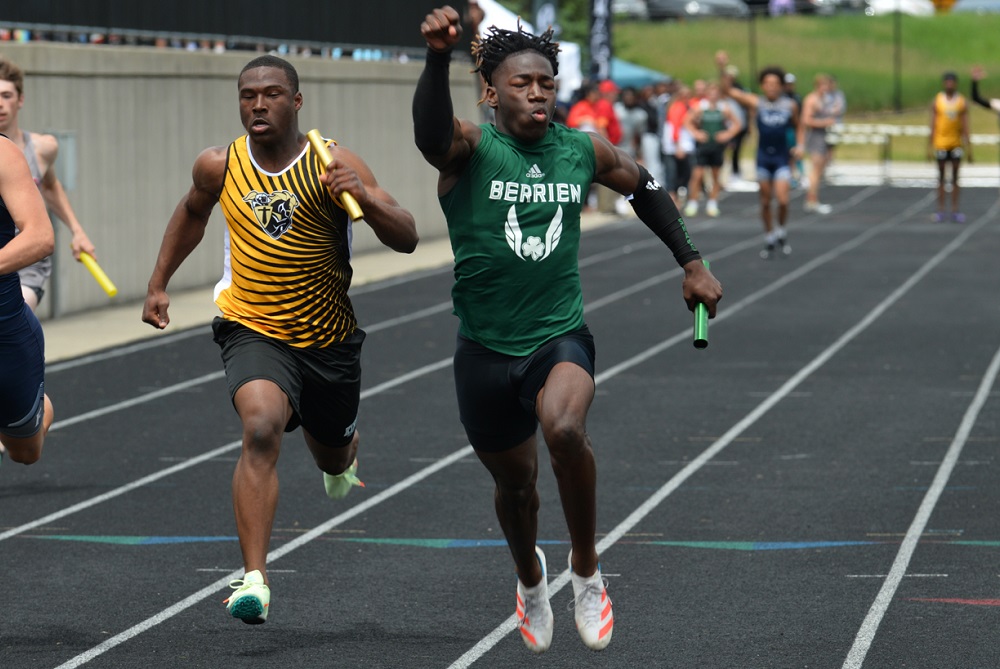
Hailey Helps Carry Berrien Springs Once More, This Time to 1st Track Title
By
Steve Vedder
Special for MHSAA.com
June 4, 2022
ADA – Don't ask Jamal Hailey to explain winning two MHSAA Finals titles without relying on his best effort.
Don't get Hailey wrong. The Berrien Springs senior is thrilled with not only winning Saturday's 100 and 200-meter dashes, but also helping his somewhat undermanned team to the Lower Peninsula Division 2 Finals championship at Forest Hills Eastern.
Hailey won the 100 with a time of 10.77, a fraction better than runner-up Ian Thompson (10.78) of Wayland. Hailey also took the 200 (22.11) over second-place Julian Bailey of Dearborn (22.25). Neither winning time was a personal best for Hailey, but he'll gladly take both his individual efforts, which resulted in 20 points. And with his inclusion on the winning 400 relay, the Western Michigan-bound Hailey was part of 30 of the team's 41 points – and nearly equaled the 33 points totaled by runner-up Forest Hills Eastern.
"I can't explain it," Hailey said. "It's preparation, being fortunate and knowing what I came here to do. I came here to win."
What is explainable is Hailey's value to a team which brought just 10 participants to the meet. Most track coaches are more comfortable with 15-20 potential point scorers, Berrien Springs coach Jon Rodriguez said. Hailey is also a standout football player who rushed for more than 2,000 yards and 33 touchdowns last fall.
The team championship was Berrien Springs' first in the sport, to go with runner-up finishes in 1953 and 2018.
"We had an idea we could win because Jamal is so special. He scores a lot of points for us," said Rodriguez, who finished up his 10th year as coach. "If we were healthy, we thought we had a chance to win. It all comes down to who can be best on that day. We were the best today."
Berrien Springs senior James York contributed a key first place in the long jump (22-10).
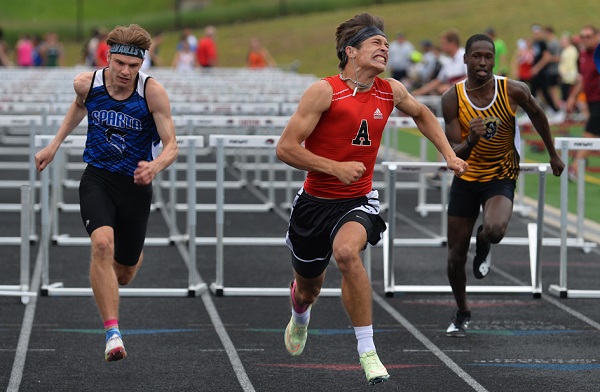 Three other Finals titles were grabbed by longtime friends Patrick Adams of Allendale and Sparta's Lance Riddle. The two seniors have competed back and forth against each other for at least the last six years and culminated in Riddle winning the 300 hurdles (39.28) and Adams capturing the 110 hurdles (14.73). Riddle was third to Adams in the 110 and Adams was only three tenths of a second behind in finishing second to Riddle in the 300.
Three other Finals titles were grabbed by longtime friends Patrick Adams of Allendale and Sparta's Lance Riddle. The two seniors have competed back and forth against each other for at least the last six years and culminated in Riddle winning the 300 hurdles (39.28) and Adams capturing the 110 hurdles (14.73). Riddle was third to Adams in the 110 and Adams was only three tenths of a second behind in finishing second to Riddle in the 300.
Adams was the 2021 champ in the 110.
"I ran faster this year," said Adams, who will attend Cornerstone University next season. "But it was definitely more competitive. It's definitely tougher trying to win back-to-back. Me and Lance have been going at it since middle school, so I know him.
"I started kinda slow, but I just trusted my training and ran. The pressure got to me a little, so I just tried harder. Honestly, you just want to get to the finals; nothing is guaranteed in the hurdles. Getting to the final is what counts."
Spring Lake's Ian Hill won the 1,600 (4:16.99) after finishing third a year ago as a junior. Hill said there was one simple explanation for jumping two spots.
"Confidence," he said. "Last year I didn't really give myself a chance. I had a lot of confidence this year even though there are a lot of good runners here. But I was confident in my ability. I have all the respect for the other runners, but I have confidence.”
Even having to bounce back from the flu bug at midseason failed to dent Hill's' confidence. He also helped the 1,600 relay to a first place (3:23.78).
"I knew this would be close, but I thought I had as much a shot as anyone else," said Hill, who will attend Michigan next season. "I'm really happy to win this."
Other champs in the running events were senior Caleb Jarema of Pinckney, who won the 3,200 (9:17.36), and Stuart Gould of Howard City Tri County in the 400 (49.18). Aiden Sullivan of Forest Hills Eastern won the 800 (1:56.40). Whitehall won the 800 relay (1:29.73), while Holland Christian took first in the 3,200 (7:54.35)
Heading the field event winners was Alex Mansfield of Monroe Jefferson, who won the shot put (57-6). The Oakland University-bound Mansfield, who was also runner-up in the discus, said the title came despite some technique difficulties.
"I couldn't get the ball to throw; it kept slipping out of my fingers," he said. "But I got the job done; you still have to perform."
Edwardsburg senior Luke Stowasser successfully repeated in the high jump (6-8). He also won the long jump a year ago, but finished runner-up this time to Berrien Springs’ York.
"It was definitely a lot tougher, but I was more confident this year, which only pushed me to be better," Stowasser said.
Landon Cosby of Charlotte won the pole vault (15-9), while Dalton DeBeau of Frankenmuth took first in the discus (175-7).
Chelsea junior Jacob Nelson competed in one of the first-time adaptive events, in the 100 (33.19).
PHOTOS (Top) Berrien Springs’ Jamal Hailey (in green) crosses the finish first in the 400 relay Saturday, just ahead of Detroit Martin Luther King’s Terrence Brown to his right. (Middle) From left, Sparta’s Lance Riddle, Allendale’s Patrick Adams and King’s Teon Parks stride toward the finish of the 110 hurdles. (Click for more from Dave McCauley/Run Michigan.)
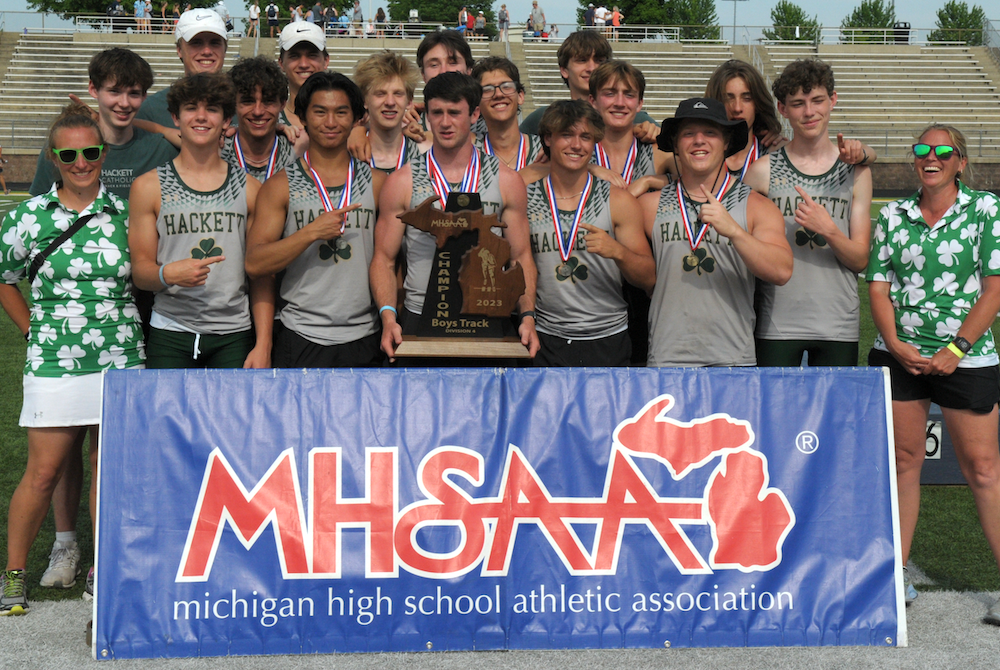
Thrower Claims Lone Individual Title to Lead Hackett to Team 3-Peat
By
Tom Lang
Special for MHSAA.com
June 3, 2023
Kalamazoo Hackett Catholic Prep just keeps winning and winning.
This time the Irish took home their fourth title in the last five Lower Peninsula Division 4 Track & Field Finals, on Saturday at Hudsonville.
Hackett’s only individual title was taken by discus winner Nathan Buchmann, a senior, who was fine knowing he was the shortest in stature among all the sizable competitors.
“In the offseason after football I worked out every day, working towards this goal,” he said after getting his medal. “I would say this takes 80 percent technique and 20 percent strength to throw the discus. So, length can help but if you have good technique and are really strong, that will play into it.
“I think we are very balanced throughout the meet today,” he said about teammates that scored points in finishes other than first place. “We have 13 guys here today, and we have people in a lot of the races. But I do not run; I have too short of legs to be a fast runner,” he said with a chuckle.
Buchmann had to work through a hip injury to compete this spring.
“I think the setbacks are what make you strong,” he said. “You can either give up through the setbacks or push forward and become better.”
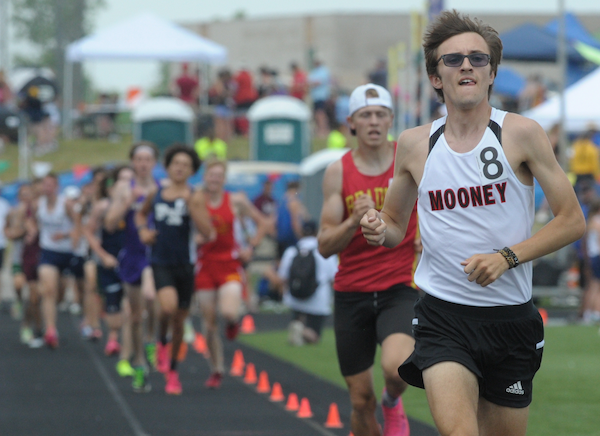 Coach Charissa Dean agreed.
Coach Charissa Dean agreed.
“The kids have big hearts,” she said after all the points were totaled and the Irish were on top once again, with 53. “They worked hard. They had a lot of potential when we started the season. And we had a lot of drive to put in the work, and we are happy the results came out the way they did.”
Reading was runner-up at 47 points, followed by Wyoming Potter’s House Christian with 42, then Fowler and Flint Beecher each with 37 points.
Senior Lezawe “Moses” Osterink, of Potter’s House Christian, placed second in 1,600 but took the 3,200 title as defending champ of both. He dominated the latter by lapping the field with a final lap kick that resembled more of a superhero speedster.
“Nobody really took it out that hard at the start,” he said. “There was a freshman (Marek Butkiewicz of Hackett) that tried to get the pace going quick, but me and Dakota (Dykhuis of Montabella) just kind of sat back and gradually pulled him through.
“We took it gradually, and I was just relying that I could kick.”
Kick did he ever. The trio were neck and neck the majority of the race in a grouping ahead of the pack.
“With 400 to go I just tried to go all out,” Osterink said. “I had a lot more left than I thought and I was pleased with the win. Not really the time, but that doesn’t matter, especially this hot out.”
The overall meet was in the low 90s/high 80s heat and searing sun all day. So, race officials allowed the unique opportunity for coaches to spray the runners with water and give them water bottles.
“It was very weird because I’ve never taken water to drink while I’m running, so I didn’t know how that would feel,” Osterink said. “And they were spraying us and hitting us in the face. It was kind of fun.”
Junior Tyler Lenn of Marine City Cardinal Mooney defeated Osterink at his own game in the 1,600.
“I’m feeling great,” Lenn said after grabbing the medal. “I said to a newspaper after one of my races (during the season) I was right where I wanted to be. This has been a long rebuilding process for me since an injury back in the fall, and I set a pretty high goal the day the injury happened. I was telling myself I needed to fulfill what I said I would do at the beginning of last cross country season. And that is what I did today.”
Lenn suffered an ankle sprain from a misstep that turned worse because he kept running through the season on it.
“Coming back from that was pretty tough, but I wouldn’t have it any other way,” he said. 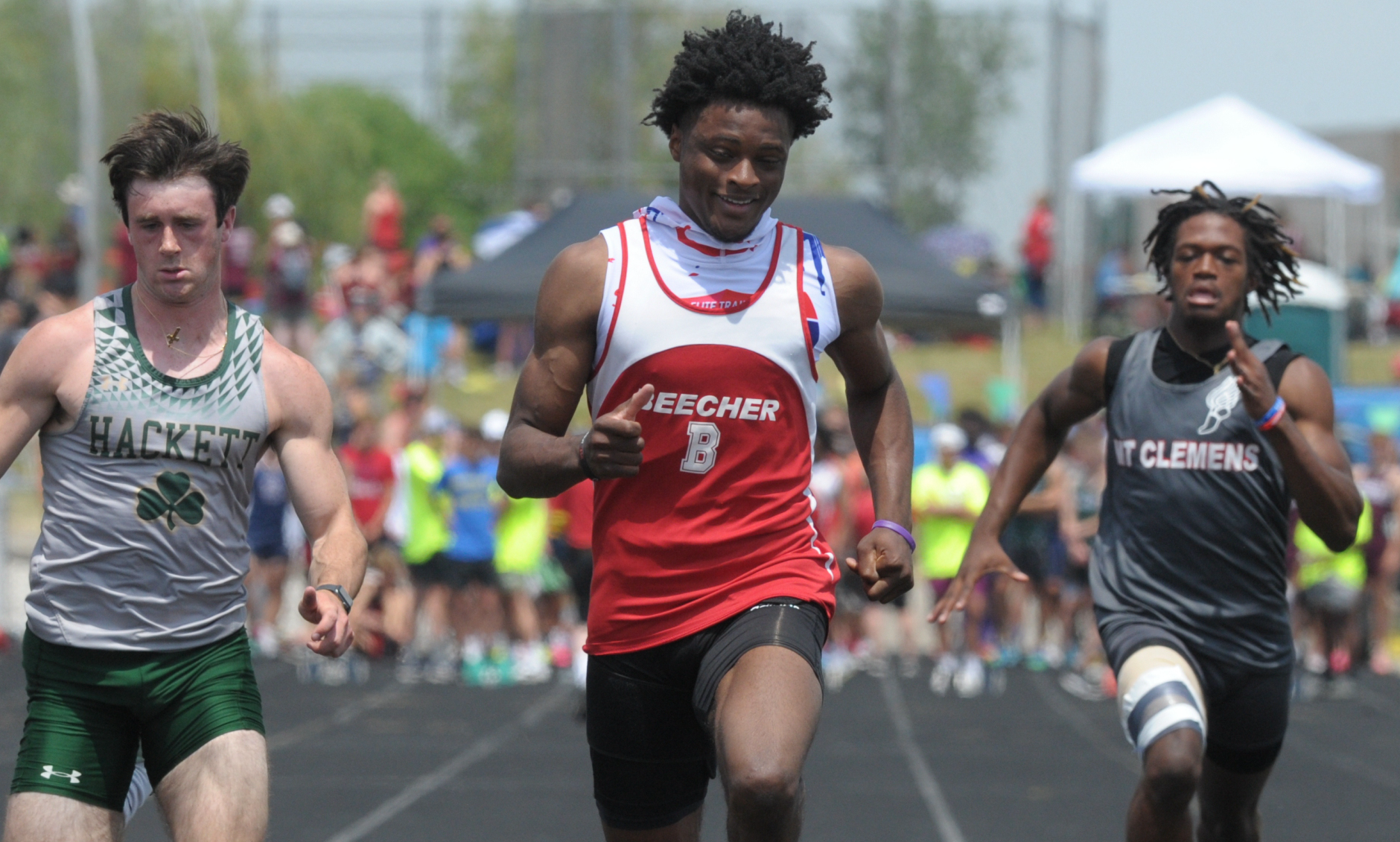 “Perseverance; I said from the beginning what I was going to do. I kept my eye on that target, and no matter the circumstances life threw at me, that I was going to make it happen and I am a man of my word.”
“Perseverance; I said from the beginning what I was going to do. I kept my eye on that target, and no matter the circumstances life threw at me, that I was going to make it happen and I am a man of my word.”
Jaylin Townsend, a senior from Flint Beecher, dominated the short races. He won the 100 dash (10.67) and 200 dash at 22 seconds flat. It was his third 100 win at a Finals.
“I put in a lot of work; I had to three-peat,” he said after the 100. “There’s a lot of great competition here, so I knew I had to come out and run my best.”
Concord in the 400 (43.72), Buckley in the 800 (1:30.76) and 1,600 (3:29.13) and Potter’s House in the 3,200 (8:14.18) were relay champs Saturday. Reading’s Tayshawn Bester won the 110 hurdles (15.13), and Athens’ Landen Bennett won the 300 (39.85). Caseville’s Nathan Feltner won the 400 (50.76), and Vestaburg’s Owen Patton claimed the 800 (1:55.11).
Fruitport Calvary Christian’s Bradley Richards won the high jump (6-10), and Peck’s Alex Affer won the long jump (23-4). McBain Northern Michigan Christian’s Isaac Bowden was first in pole vault (13-0), and Brown City’s Kyle Affer won shot put (49-2).
PHOTOS (Top) Kalamazoo Hackett Catholic Prep celebrates its third-straight LPD4 title Saturday. (Middle) Cardinal Mooney's Tyler Lenn, far right, sets the pace in the 1,600. (Below) Flint Beecher's Jaylin Townsend, middle, crosses the finish first for one of his two sprint championships. (Photos by Ken Swart/RunMichigan.com.)

